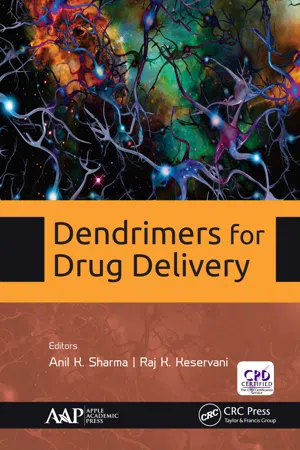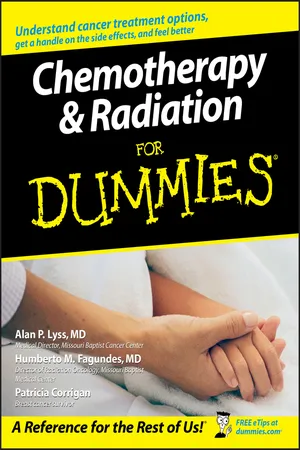Chemistry
Anti-Cancer Drugs
Anti-cancer drugs are medications used to treat cancer by inhibiting the growth and spread of cancer cells. They work through various mechanisms, such as targeting specific molecules involved in cancer cell growth or interfering with the cell division process. These drugs can be administered through different routes, including oral, intravenous, or topical application, and are often used in combination with other cancer treatments.
Written by Perlego with AI-assistance
Related key terms
6 Key excerpts on "Anti-Cancer Drugs"
- eBook - ePub
- Anil K. Sharma, Raj K. Keservani(Authors)
- 2018(Publication Date)
- Apple Academic Press(Publisher)
Among the above-mentioned strategies of cancer treatment, chemotherapy is the most common, but still far from satisfactory. Its efficiency is usually limited by low specificity of action of the drugs, which is responsible for various side effects, as well as unfavorable biodistribution and low solubility. Variable microenvironment and drug resistance of cancer cells constitute another obstacle toward drug effectiveness. Therefore, the intensive research is carried out to develop a capable delivery system, which could improve the efficacy of the traditional chemotherapy, at the same time reducing side effects and overcoming the multidrug resistance. To date, a series of nanoparticles, including nanotubes, liposomes, and dendrimers have been tested for their potential use as drug-delivery devices. Numerous studies indicate that the latter seem to be the best nanocarriers for many therapeutic compounds, mainly due to their well-defined structure, high reactivity, biocompatibility, and solubility.In this chapter, we summarize available data on the possibility of application of dendrimers as carriers for anticancer drugs and highlight the recent achievements in this field.10.2 Anticancer Drugs: History, Principle of Action and LimitationsThe term “chemotherapy” was proposed by Paul Ehrlich, German physician and scientist, winner of the Nobel Prize in Physiology or Medicine in 1908. Chemotherapy is a method of cancer treatment that utilizes one or a combination of anticancer drugs as part of a standardized treatment, which is meant to cure the patient or prolong his or her life and reduce symptoms of the illness. Because other ways of treatment often do not bring promising results, cancer chemotherapy continues to play an increasingly important role in the management of malignancies, either directly or as an adjuvant to surgery and/or radiotherapy.Numerous currently used chemotherapeutics have been discovered as a result of both in vitro (in murine and/or human cancer cell lines) and in vivo (in rodent tumor models) screening for compounds with proper cytotoxic activity. Typically, anticancer drugs are natural products or synthetic agents designed to target specific functions of tumor cells.The beginnings of chemotherapy date back to 1861, when the antitumor effect of an extract from the roots of Podophyllum peltatum has been described for the first time by Robert Bentley. Twenty years later, in 1881, the active element of this extract was discovered and named “picropodophyllin.” The mechanism of action of this compound, which involves inhibition of mitotic spindle formation, and thus, cell cycle arrest, was characterized in 1946. Further research on picropodophyllin led to the synthesis of two structural analogs – etoposide and teniposide, being even more effective than the original compound against many kinds of tumors (Jones, 2014 - Yearul Kabir, Yearul Kabir(Authors)
- 2020(Publication Date)
- Academic Press(Publisher)
Karkinos to describe tumors, but cancer history begins much earlier. It is difficult to recognize the neoplasm diagnosis in ancient texts just from the literary description. However, progress in understanding and treating tumors has been slow and centered on pathological anatomy development, starting in the 18th century.Cancer is one of the most impactful diseases of the 21st century. Cancer affects people of diverse social, ethnic, and economic factors. In recent years, the genetic, epigenetic, and pathophysiological mechanisms of cancer have been well described, but cancer is still the second-leading cause of death in developed countries, following heart disease (de Oliveira Junior et al., 2018 ).Cancer cells, to ensure their survival and proliferation, acquire some specific abilities compared to normal cells. During the onset of malignant tumors, they may present constitutively active proto-oncogenes, deactivating the expression of some tumor-suppressor genes.Tumor cells typically show replicative immortality mechanisms (Shay, 2016 ) and greater resistance to cell death mediated by the regulation of anti- and proapoptotic proteins (Hassan et al., 2014 ).Chemotherapy is one of the strategies available for tumor treatment. Chemotherapy utilizes compounds capable of preventing proliferative signaling pathways, blocking immortality mechanisms, and preventing angiogenesis, pushing cancer cells toward apoptosis (de Oliveira Junior et al., 2018 ).Anticancer products from nature
Over the past decades, there has been rising interest in the use of bioactive components from natural sources as potential novel anticancer agents as well as the identification of chemical entities, molecular targets, and signaling pathways activated or inhibited by these natural products (Sak and Everaus, 2017 ).Natural compounds have historically been utilized in cancer treatment, especially in traditional Chinese or Indian Ayurveda medicine. The term “natural compound” specifies chemical substances found in plants, fungi, and marine animals or those produced by microbes, with important pharmacological effects (Rejhova et al., 2018- eBook - ePub
Scott-Brown's Otorhinolaryngology and Head and Neck Surgery
Volume 1: Basic Sciences, Endocrine Surgery, Rhinology
- John C Watkinson, Ray W Clarke(Authors)
- 2018(Publication Date)
- CRC Press(Publisher)
CHAPTER 4MECHANISMS OF ANTICANCER DRUGS
Sarah Payne and David MilesIntroduction Principles of chemotherapy Principles of tumour biology Classification of chemotherapeutic agents Chemotherapy in head and neck cancer Choice of chemotherapy in head and neck cancer Chemotherapy strategies Novel therapies for the future Immunotherapy Conclusion ReferencesSEARCH STRATEGYData in this chapter may be updated by a PubMed search using the keywords: mechanisms of chemotherapy; principles of tumour biology, chemotherapy and head and neck cancer; EGFR inhibitors, EGFR monoclonal antibodies; VEGF inhibitors, immunotherapy and head and neck cancer.INTRODUCTION
Anticancer drugs have been developed and used medically since the 1940s, following the observation that nitrogen mustard gas, a chemical warfare agent used in the Second World War, interfered with haematopoiesis. Since then there have been significant therapeutic advances in the development of anticancer drugs although a cure for all cancer types remains an elusive goal. Alongside trials using more traditional types of chemotherapy, there is also now significant interest in developing more target-directed drug therapies and novel therapies, including immunotherapy.PRINCIPLES OF CHEMOTHERAPY
Cancer is defined as the uncontrolled growth of cells coupled with malignant behaviour: invasion and metastasis. It arises through a complex interaction between genetic and environmental factors, causing genetic mutations in oncogenes and tumour suppressor genes. Chemotherapy aims to exploit the resulting differences in biological and proliferative characteristics between normal and cancer cells where most cytotoxic drugs preferentially affect dividing cells in tumours.PRINCIPLES OF TUMOUR BIOLOGY
Cellular kinetics
CELL CYCLE
The cell cycle (Figure 4.1 - eBook - ePub
- Walter H. Hsu(Author)
- 2013(Publication Date)
- Wiley-Blackwell(Publisher)
Chapter 17
Antineoplastic Drugs
Leslie E. FoxI. GENERAL PRINCIPLES OF CANCER CHEMOTHERAPY
A. The goal of treatment with chemotherapy in veterinary medicine is to increase the length and quality of life of patients based on an accurate histologic diagnosis of the tumor and the clinical stage or extent of the neoplastic process.B. Chemotherapy is best used as treatment for systemic disease, palliation for metastatic, or nonresectable disease, large tumor size reduction, making them more amenable to surgery and/or radiation therapy called neoadjuvant chemotherapy, adjuvant therapy after surgery and/or radiation therapy to slow metastasis or kill residual tumor cells, and to increase tumor cell sensitivity to the lethal effects of radiation therapy.C. The kinetics of chemotherapy drug-induced cell kill is first-order —a constant percentage (not a constant number) of cells is killed with each dose. Antineoplastic drugs are most effective when the tumor is small (microscopic) and is rapidly growing (high growth fraction).D. Because tumor cells undergo a high spontaneous mutation rate, up to 1 in every 10,000 tumor cells may have acquired mutations that can confer resistance at the time of diagnosis, even in the absence of previous exposure to chemotherapeutic agents. Thus, multimodality and multiagent therapy administered as early in the course of disease as is possible, is likely to be the most helpful.E. Drug resistance develops in neoplastic cells with mechanisms similar to those observed in antibiotic resistant bacteria. These include the following:1. Decreased cell permeability or uptake, or increased efflux of drugs2. Increased production of enzymes which degrade the drug3. Increased capacity to repair or bypass the effects of the drug4. Decreased binding of drug to receptors or target enzymesF - eBook - ePub
- Alan P. Lyss, Humberto Fagundes, Patricia Corrigan(Authors)
- 2011(Publication Date)
- For Dummies(Publisher)
Chapter 4
Defining Chemotherapy: The Anticancer Drugs
In This Chapter
Decoding the pharmacopoeiaDifferentiating among the delivery systemsExploring scientific advances in chemotherapyMaking a treatment planMoving forwardC hemotherapy, or anticancer drug therapy, is a systemic treatment for cancer, which means that chemotherapy drugs move through the bloodstream to all parts of the body.Time was when the word chemotherapy elicited almost as much fear as the word cancer. People heard “chemotherapy” and shuddered, because this particular treatment had a reputation for being as hard on the body as cancer itself. In some circles today, chemotherapy still is thought of as poison.No doubt about it, chemotherapy is strong medicine. It has to be. The job of chemotherapy is to cure or control cancer, a disease that kills 1,500 Americans every day, according to the National Cancer Institute. One big reason more people don’t die of cancer is the effectiveness of chemotherapy.There’s no question that undergoing chemotherapy can be rough. But many drugs have been developed to help offset some of the more disabling side effects of chemotherapy. Also, for a host of reasons, every individual responds to chemotherapy differently, so “rough” can range from profound fatigue to hospitalization. You may want to decide that instead of fearing chemotherapy, you will simply respect it for its power — and its possibilities.In this chapter, we introduce you to different chemotherapy regimens and offer some guidelines on working with your doctor to choose the best one for you.Getting Some Chemotherapy Basics
- eBook - ePub
- Prakash Srinivasan Timiri Shanmugam(Author)
- 2018(Publication Date)
- CRC Press(Publisher)
3 Phytopharmaceuticals in Cancer Treatment Prince Clarance and Paul AgastianContents Introduction Natural Anticancer Agents Plant-Derived Anticancer Agents Anticancer Agents from Microorganisms Anticancer Agents from Bacteria The Ideal Bacterial Anticancer Agent Anticancer Agents from Endophytic Bacteria Anticancer Agents from Fungi Phytopathogenic Fungi Cytochalasins Fusicoccanes Metabolites from Toxigenic Fungi BisorbicillinoidsIntroductionSesquiterpene and Eurochevalierine from Neosartorya pseudofischeriMetabolites from Nontoxigenic FungiTryprostatins A&B from Aspergillus fumigatusHalenaquinones from Xestospongia cf. Carbonariai (A Sponge)Anticancer Agents from Endophytic Fungi Taxol Camptothecin Vincristine Sclerotiorin Berberine Anticancer Agents from Marine Organisms Didemnin B ET-743 Conclusion Acknowledgment ReferencesCancer is a group of diseases that can affect various organs of the body and is characterized by the uncontrolled growth of abnormal cells and invasion into normal tissue. Cancer cells can also spread to other parts of the body and produce new tumors (Kharwar et al. 2011). Cancer remains one of the most predominant illnesses causing death, where each year more than 10 million people are identified worldwide (Saeidnia and Abdollahi 2014), and 7.4 million cancer-related deaths occur every year (Jemal et al. 2011). The aim of most cancer chemotherapeutic drugs is to inhibit the mechanism implied in the cellular division and thus destroy the malignant tumor cells. Cancer therapy is a very difficult task due to nonspecific toxicity and the severe drug resistance of most anticancer drugs (Nygren and Larsson 2003). The disease treatment becomes extremely difficult with the limited number of chemotherapies and their detrimental side effects and the high costs of the drugs. Many existing therapies do not effectively treat certain types of cancers, and multi-drug-resistant tumors aggravate the challenge ahead. The discovery of new natural chemotherapeutic agents is of great relevance.
Learn about this page
Index pages curate the most relevant extracts from our library of academic textbooks. They’ve been created using an in-house natural language model (NLM), each adding context and meaning to key research topics.





